Abstract
The author reviews the results of experimental infections of various species of mammals, other than man, with S. haematobium and S. mansoni, and discusses investigations in Africa and Brazil into the possibility of the natural infection of non-human vertebrates with these two parasites. Only a few species, besides monkeys, could be easily infected with S. haematobium in the laboratory, while—outside man—natural infection with this parasite appears to be practically non-existent. On the other hand, many animals are good experimental hosts for S. mansoni, and at least 21 species of mammals have been found infected with this parasite in Africa and America. It is thus possible to state, provisionally, that man is the only reservoir of S. haematobium, but the question still remains open where S. mansoni is concerned. Further research is suggested in order to assess the importance of non-human reservoirs in the epidemiology of bilharziasis.
Full text
PDF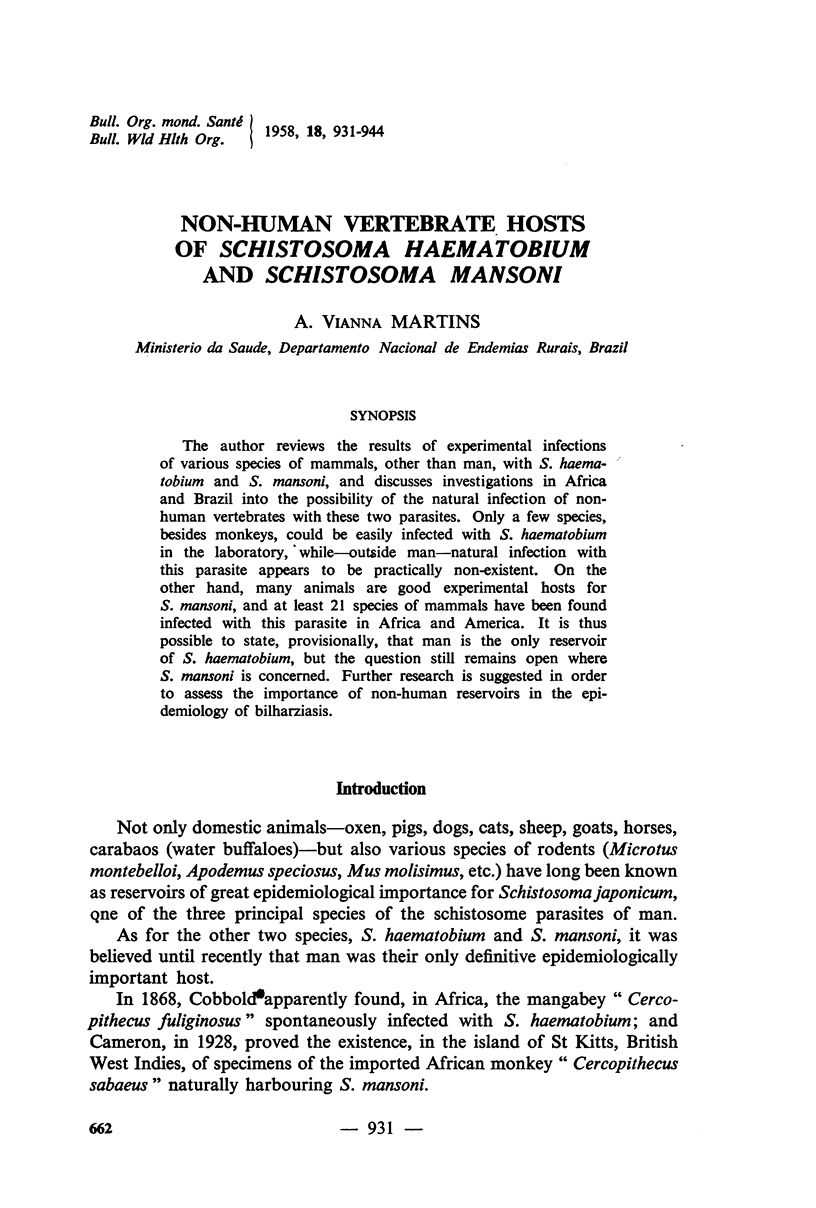
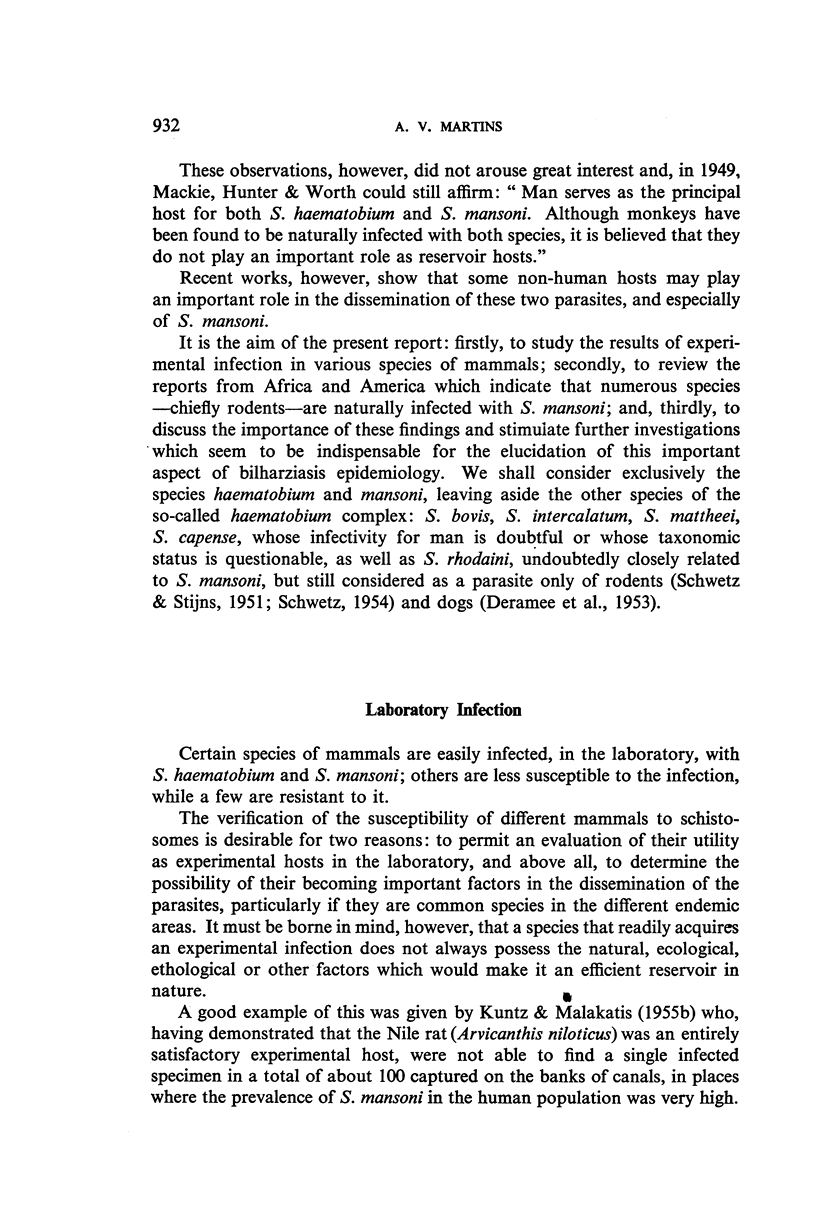
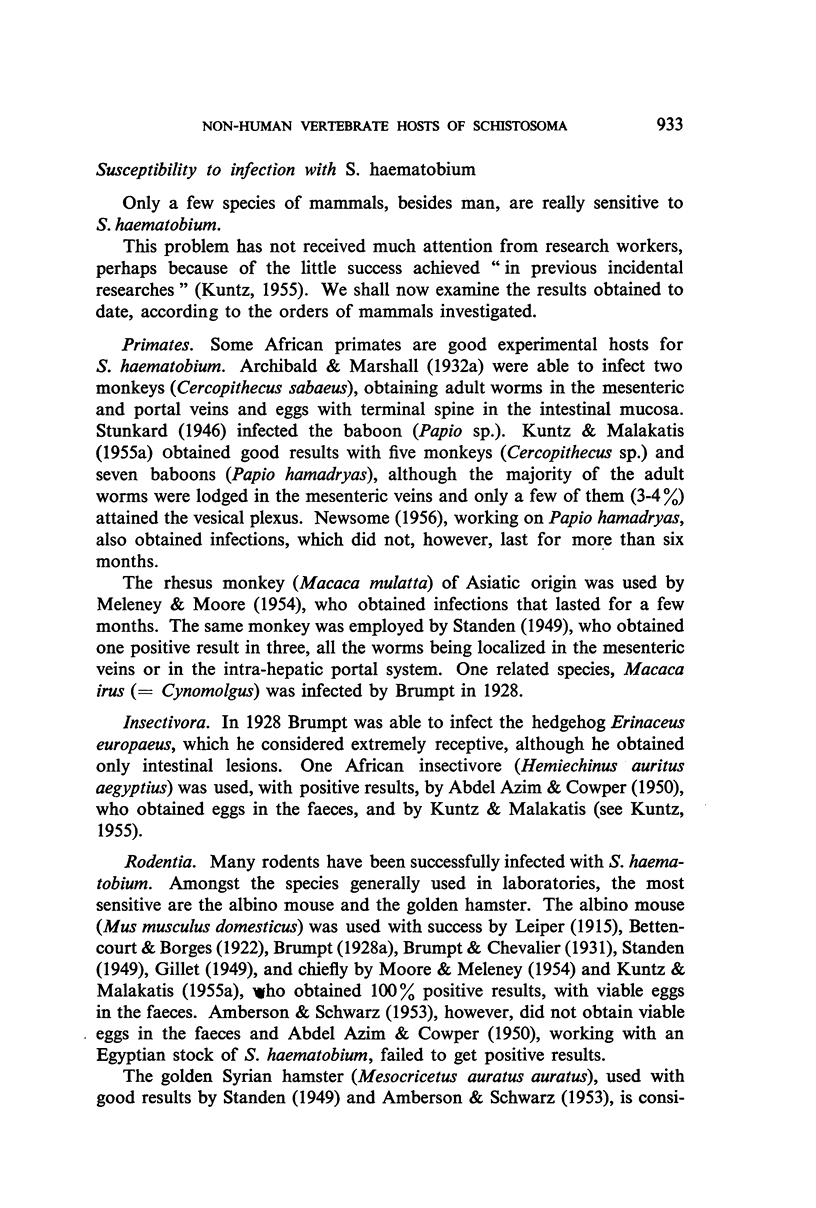
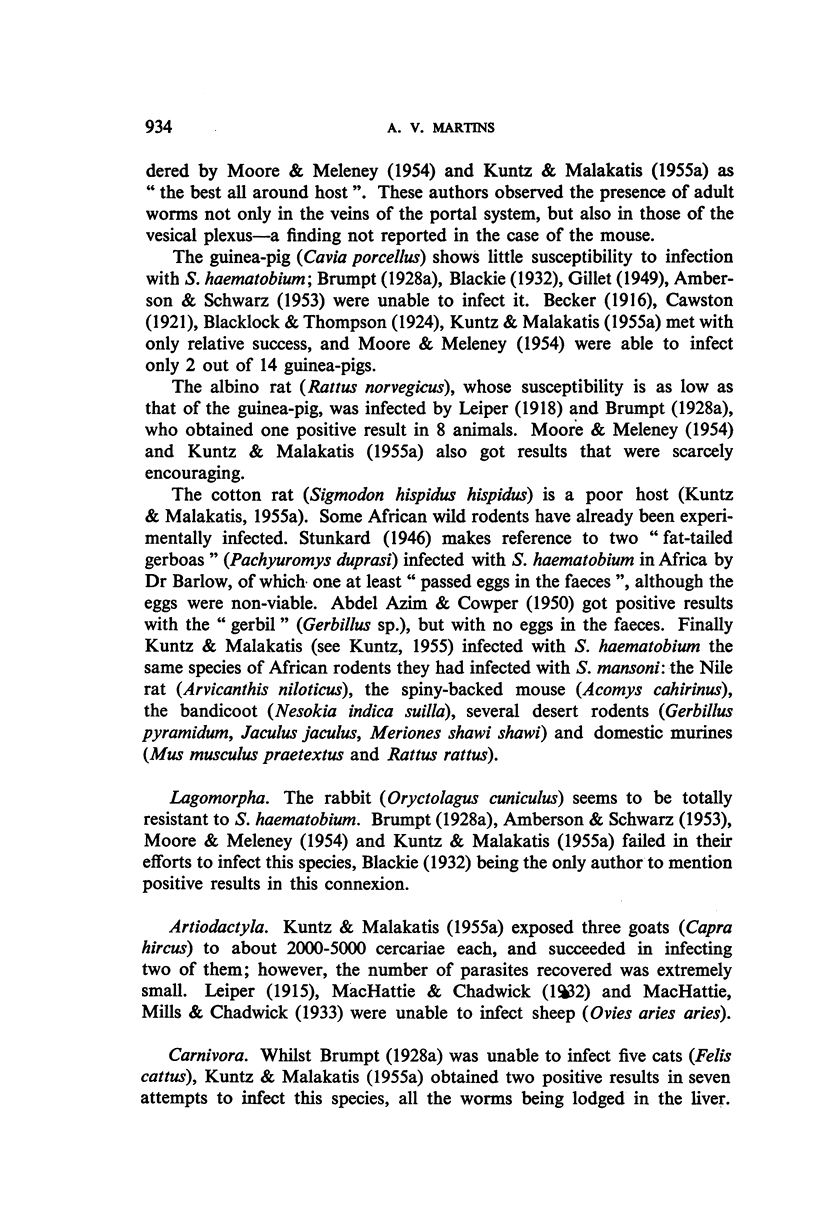
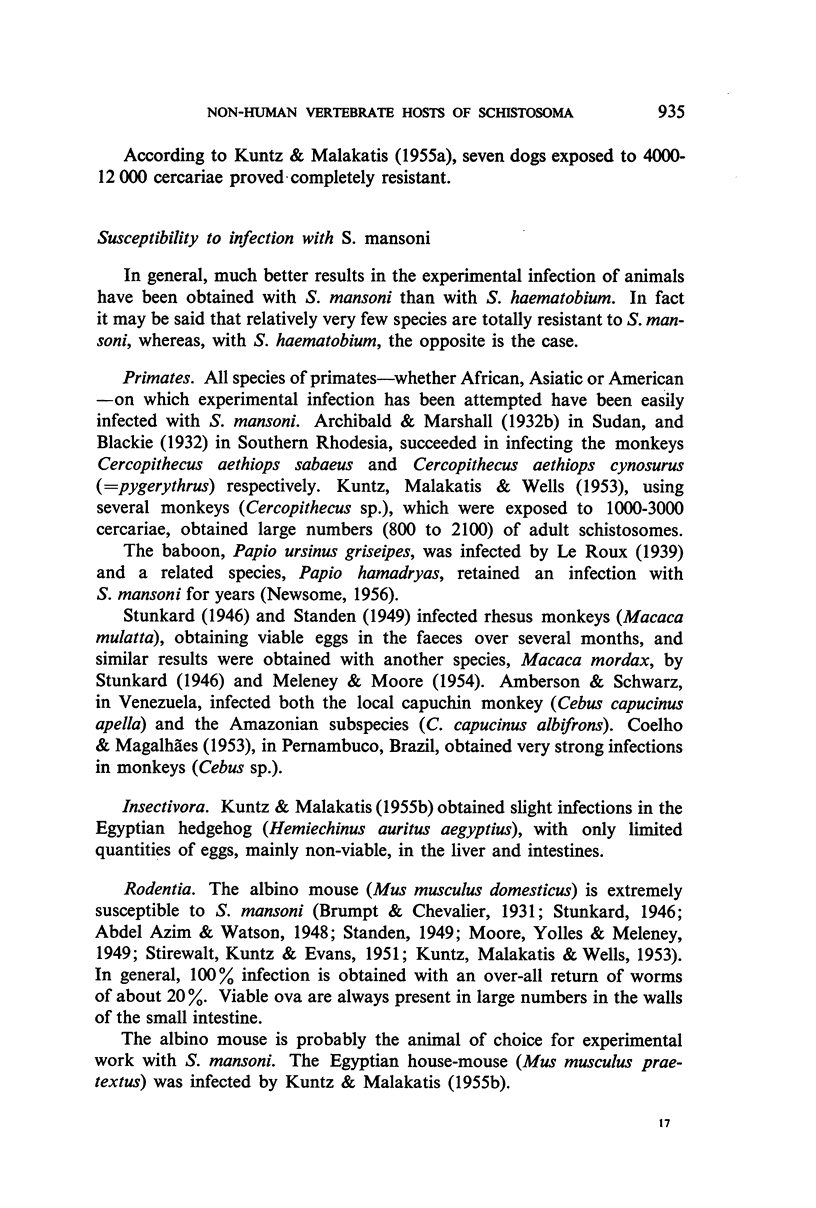
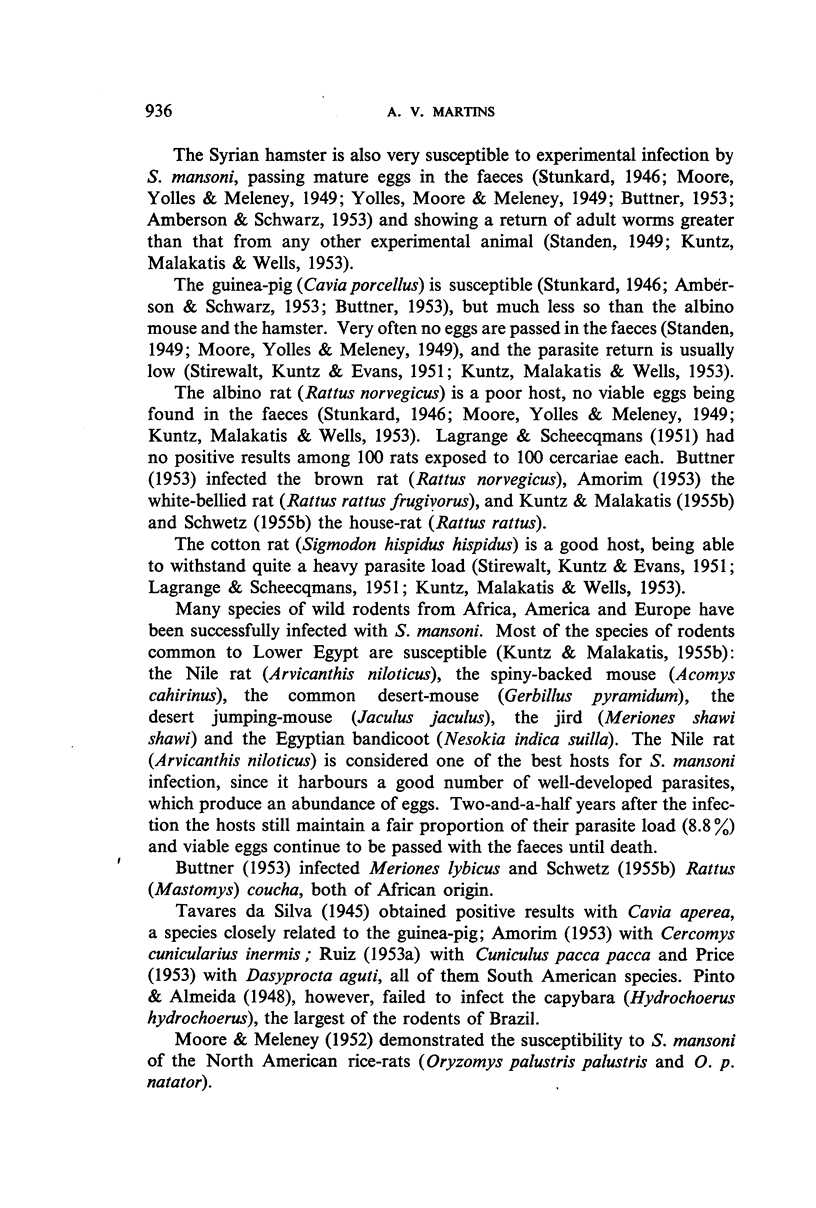
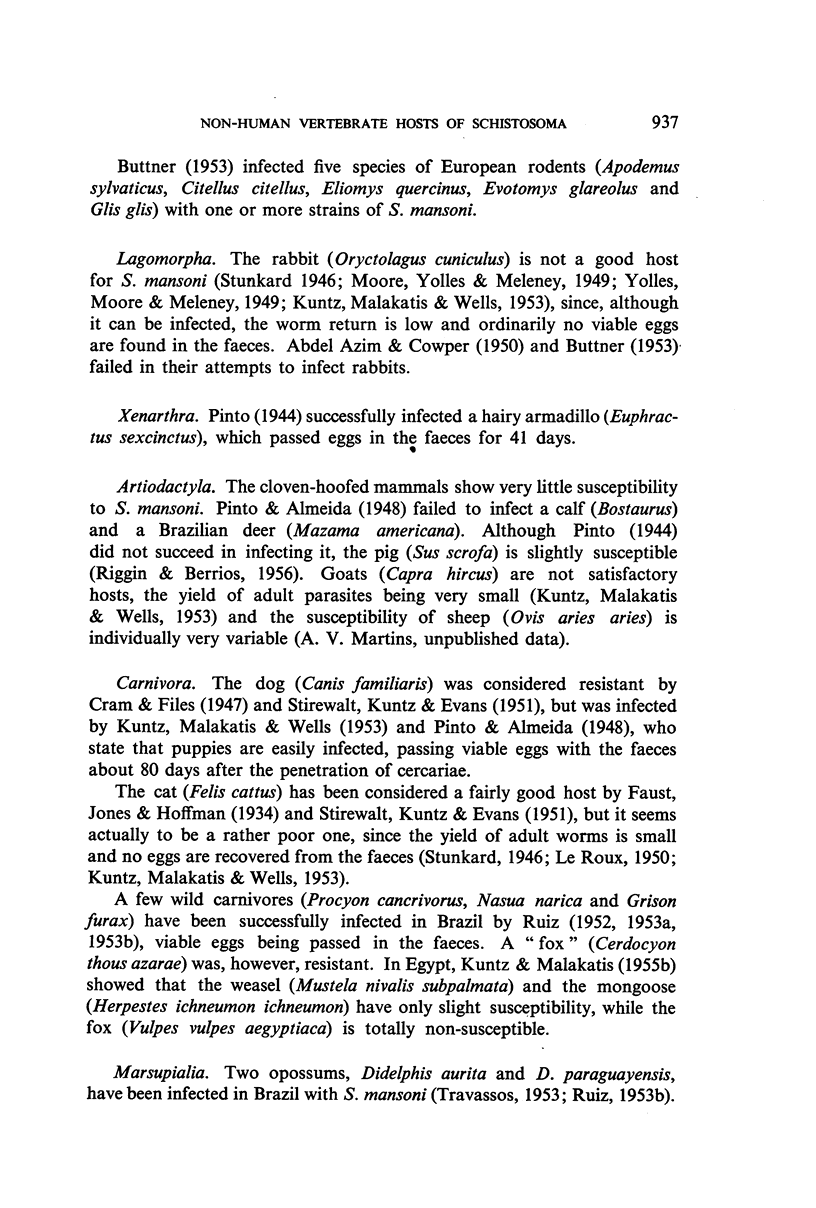
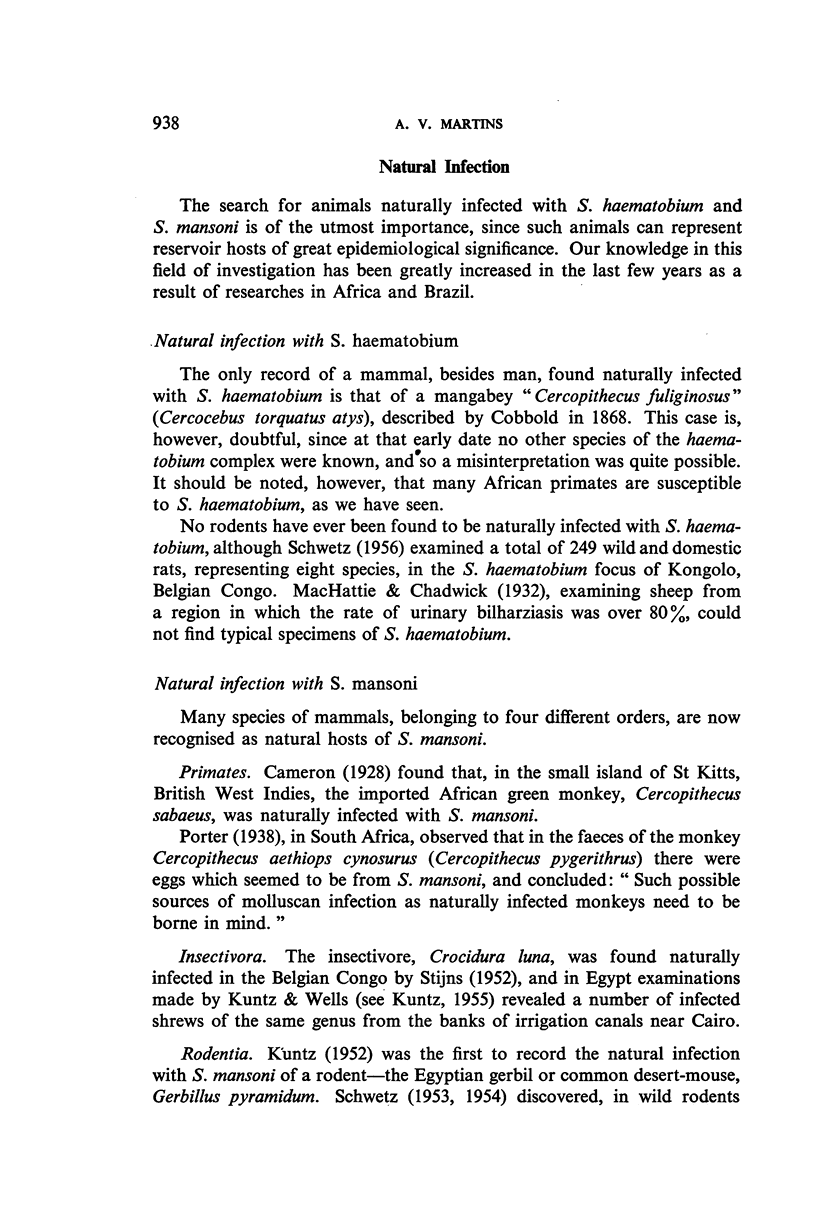
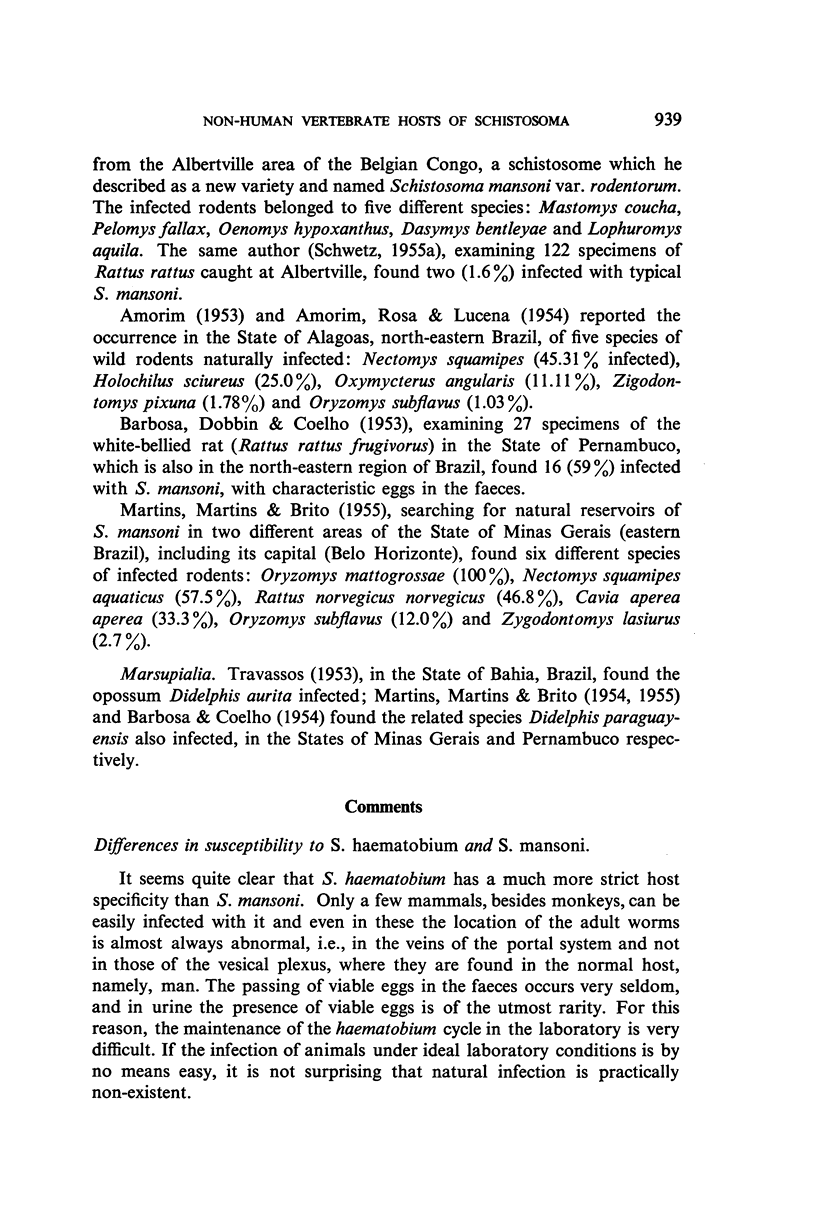
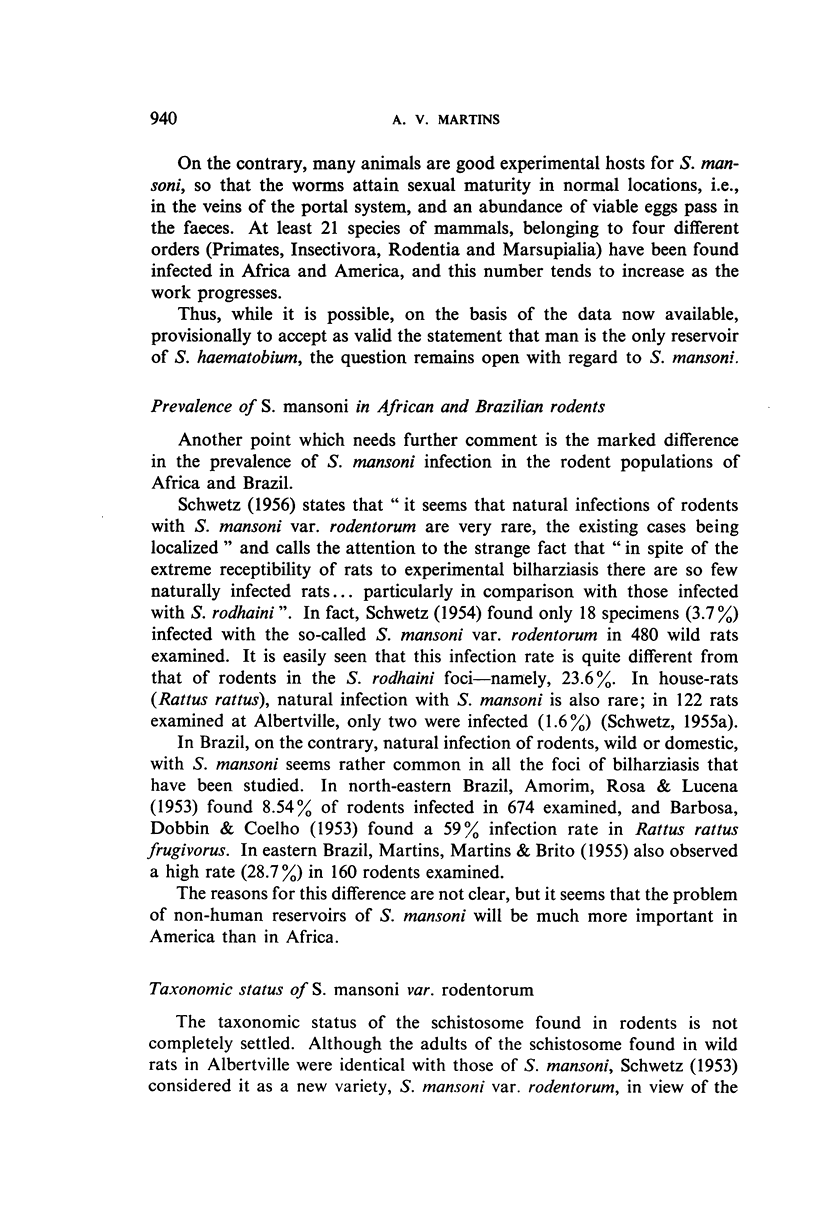
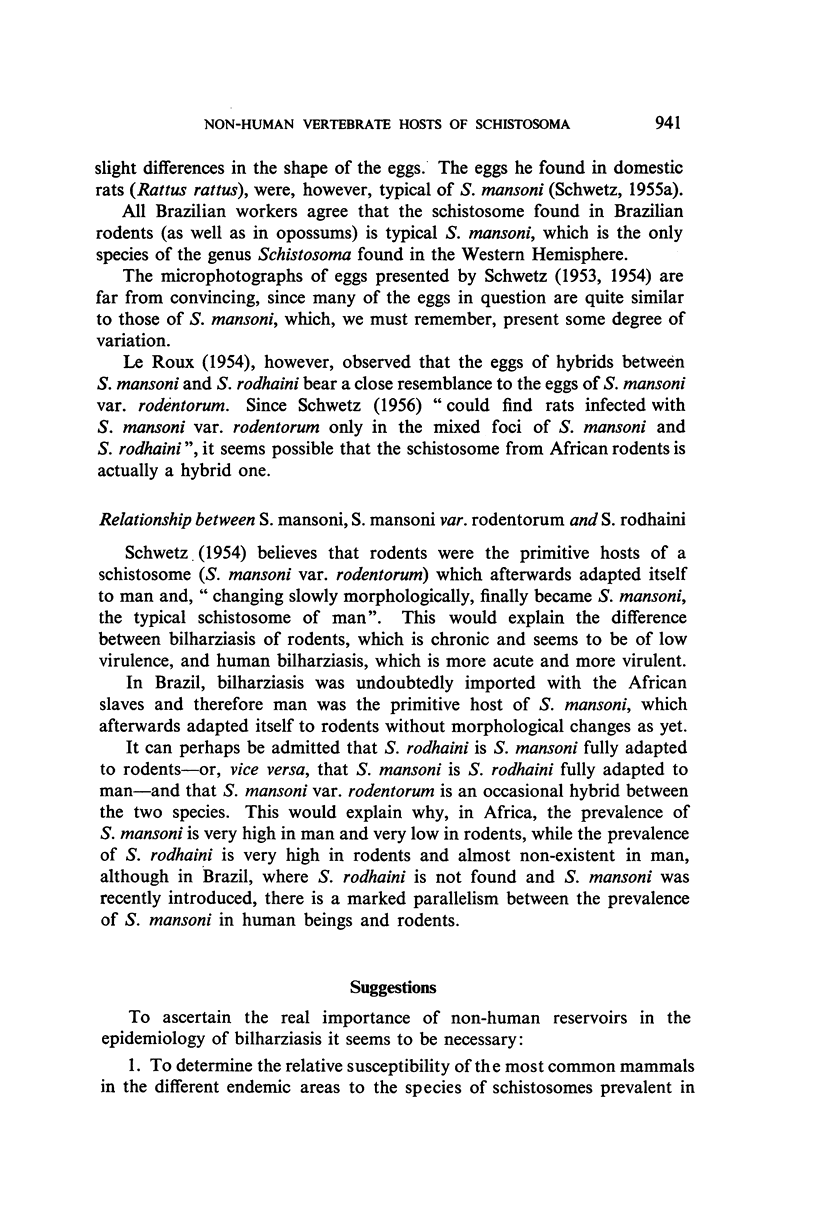
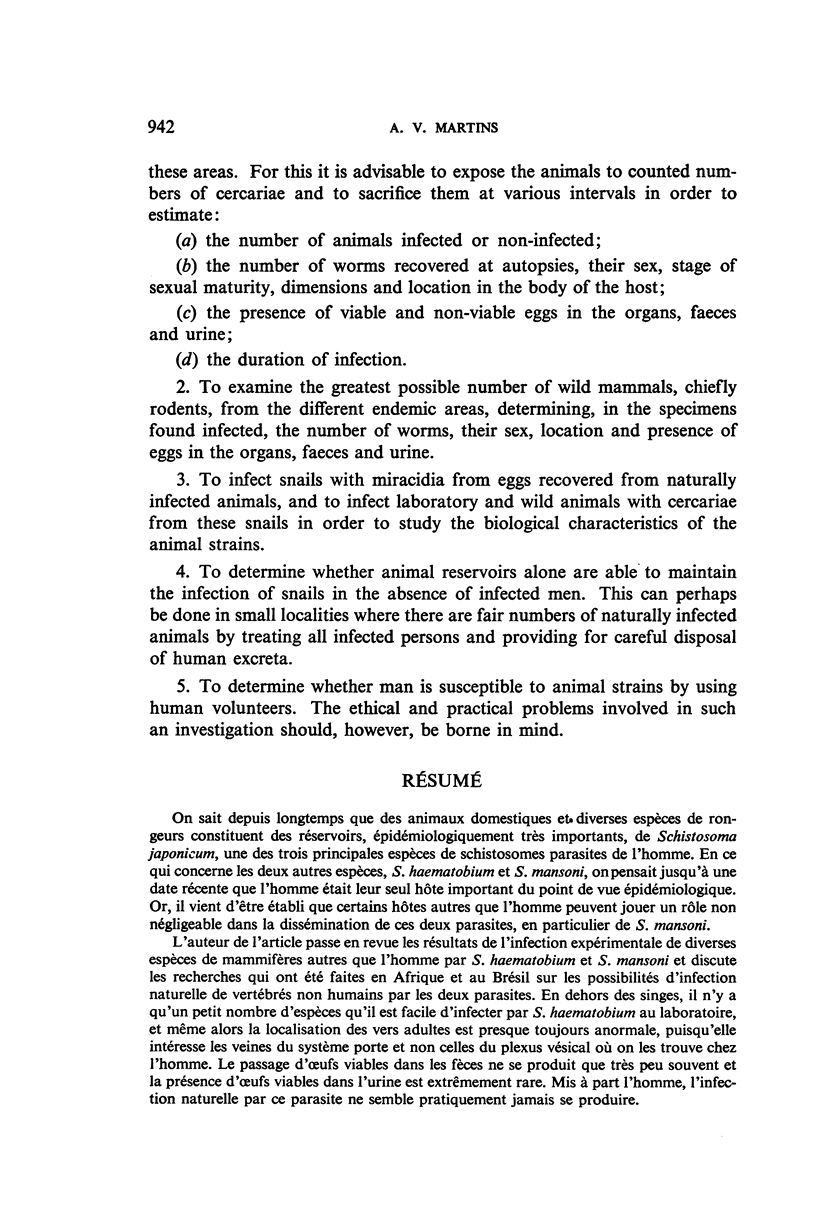
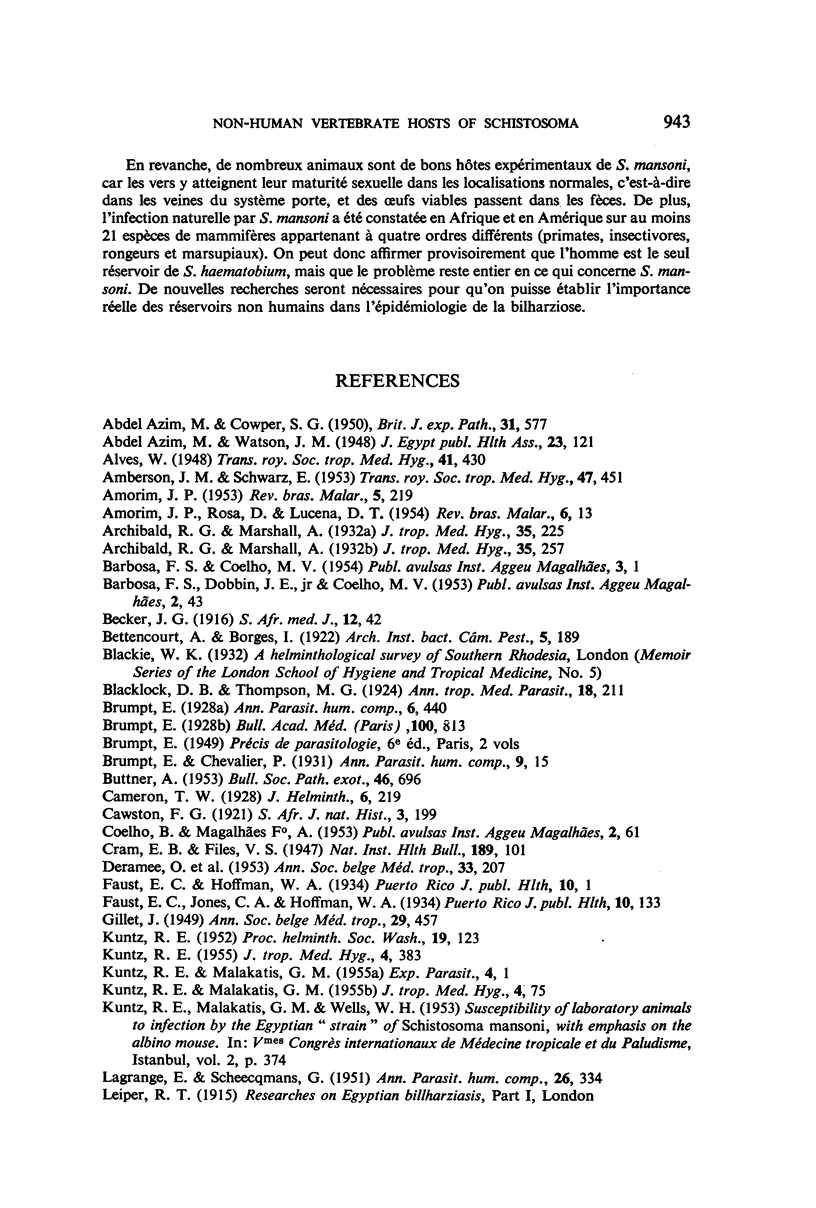
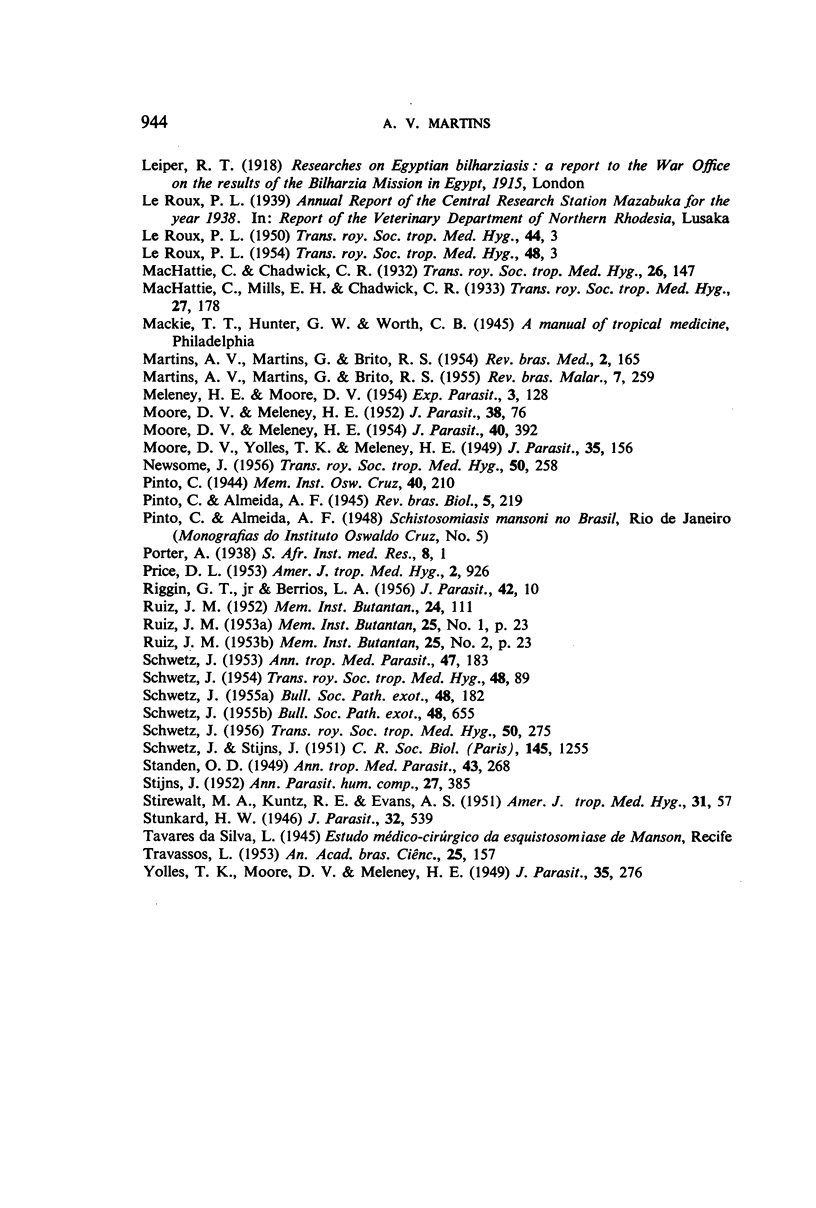
Selected References
These references are in PubMed. This may not be the complete list of references from this article.
- ABDEL AZIM M., COWPER S. G. On the maintenance of strains of Schistosoma mansoni, S. haematobium and S. matthei in the laboratory in Egypt, with special reference to the use of gerbils. Br J Exp Pathol. 1950 Oct;31(5):577–589. [PMC free article] [PubMed] [Google Scholar]
- AMBERSON J. M., SCHWARZ E. On African schistosomiasis. Trans R Soc Trop Med Hyg. 1953 Nov;47(6):451–502. doi: 10.1016/s0035-9203(53)80003-9. [DOI] [PubMed] [Google Scholar]
- BUTTNER A. Sur l'aptitute de certains rongeurs sauvages a devenir réservoirs de virus de la bilharziose intestinale humaine; note préliminaire. Bull Soc Pathol Exot Filiales. 1953;46(5):696–700. [PubMed] [Google Scholar]
- DE AMORIM J. P., DA ROSA D., DE LUCENA D. T. Ratos silvestres, reservatórios do Schistosoma mansoni no nordeste do Brasil. Rev Bras Malariol Doencas Trop. 1954 Jan;6(1):13–33. [PubMed] [Google Scholar]
- DE AMORIM J. P. Infestaço experimental è natural de murädeos pelo Schistosoma mansoni; nota prévia. Rev Bras Malariol Doencas Trop. 1953 Jul;5(3):219–222. [PubMed] [Google Scholar]
- DERAMEE O., THIENPONT D., FAIN A., JADIN J. Sur un foyer de Bilharziose canine à Schistosoma rodhaini Brumpt au Ruanda-Urundi; note préliminaire. Ann Soc Belg Med Trop (1920) 1953 Jun 30;33(3):207–209. [PubMed] [Google Scholar]
- KUNTZ R. E. Biology of the schistosome complexes. Am J Trop Med Hyg. 1955 May;4(3):383–413. doi: 10.4269/ajtmh.1955.4.383. [DOI] [PubMed] [Google Scholar]
- KUNTZ R. E., MALAKATIS G. M. Susceptibility studies in schistosomiasis. II. Susceptibility of wild mammals to infection by Schistosoma mansoni in Egypt, with emphasis on rodents. Am J Trop Med Hyg. 1955 Jan;4(1):75–89. doi: 10.4269/ajtmh.1955.4.75. [DOI] [PubMed] [Google Scholar]
- KUNTZ R. E., MALAKATIS G. M. Susceptibility studies in schistosomiasis. III. Infection of various experimental hosts with Schistosoma haematobium in Egypt. Exp Parasitol. 1955 Jan;4(1):1–20. doi: 10.1016/0014-4894(55)90017-5. [DOI] [PubMed] [Google Scholar]
- LAGRANGE E., SCHEECQMANS G. La bilharziose experimentale a B. manson chez le cotton-rat (Sigmodon hispidus). Ann Parasitol Hum Comp. 1951;26(4):334–337. doi: 10.1051/parasite/1951264334. [DOI] [PubMed] [Google Scholar]
- MARTINS A. V., MARTINS G., DE BRITO J. S. Os marsupiais como reservatório da esquistossomose mansónica; nota prévia. Rev Bras Med. 1954 Mar;11(3):165–166. [PubMed] [Google Scholar]
- MARTINS A. V., MARTINS G., DE BRITO R. S. Reservatórios silvestres do Schistosoma mansoni no Estado de Minas Gerais. Rev Bras Malariol Doencas Trop. 1955 Apr;7(2):259–265. [PubMed] [Google Scholar]
- MELENEY H. E., MOORE D. V. Observations on immunity to superinfection with Schistosoma mansoni and S. haematobium in monkeys. Exp Parasitol. 1954 Mar;3(2):128–139. doi: 10.1016/0014-4894(54)90003-x. [DOI] [PubMed] [Google Scholar]
- MOORE D. V., MELENEY H. E. Comparative susceptibility of common laboratory animals to experimental infection with Schistosoma haematobium. J Parasitol. 1954 Aug;40(4):392–397. [PubMed] [Google Scholar]
- MOORE D. V., MELENEY H. E. Susceptibility of rice rats (Oryzomys Palustris) to Schistosoma mansoni. J Parasitol. 1952 Feb;38(1):76–79. [PubMed] [Google Scholar]
- MOORE D. V., YOLLES T. K., MELENEY H. E. A comparison of common laboratory animals as experimental hosts for Schistosoma mansoni. J Parasitol. 1949 Apr;35(2):156–170. [PubMed] [Google Scholar]
- NEWSOME J. Problems of fluke immunity: with special reference to schistosomiasis. Trans R Soc Trop Med Hyg. 1956 May;50(3):258–274. doi: 10.1016/0035-9203(56)90033-5. [DOI] [PubMed] [Google Scholar]
- PRICE D. L. Laboratory infection of the agouti, Dasyprocta aguti, with Schistosoma mansoni. Am J Trop Med Hyg. 1953 Sep;2(5):926–929. doi: 10.4269/ajtmh.1953.2.926. [DOI] [PubMed] [Google Scholar]
- RUIZ J. M. Schistosomose experimental. I. Receptividade de Procyon cancrivorus à infestaço pelo Schistosoma mansoni. Mem Inst Butantan. 1952;24(2):111–113. [PubMed] [Google Scholar]
- SCHWETZ J. Infection expérimentale des rats de maison (Rattus rattus) par divers Schistosomes. II. Bull Soc Pathol Exot Filiales. 1955;48(5):655–658. [PubMed] [Google Scholar]
- SCHWETZ J. On a new schistosome of wild rodents found in the Belgian Congo, Schistosoma mansoni var. rodentorum var. nov. Ann Trop Med Parasitol. 1953 Jun;47(2):183–186. doi: 10.1080/00034983.1953.11685559. [DOI] [PubMed] [Google Scholar]
- SCHWETZ J. On two Schistosomes of wild rodents of the Belgian Congo: Schistosoma rodhaini brumpt, 1931; and Schistosoma mansoni var. rodentorum schwetz, 1953; and their relationship to S. mansoni of man. Trans R Soc Trop Med Hyg. 1954 Jan;48(1):89–100. doi: 10.1016/0035-9203(54)90043-7. [DOI] [PubMed] [Google Scholar]
- SCHWETZ J. Role of wild rats and domestic rats (Rattus rattus) in schistosomiasis of man. Trans R Soc Trop Med Hyg. 1956 May;50(3):275–282. doi: 10.1016/0035-9203(56)90034-7. [DOI] [PubMed] [Google Scholar]
- SCHWETZ J., STIJNS J. Sur la redécouverte de Schistosoma rodhaini Brumpt et la découverte de son hôte définitif. C R Seances Soc Biol Fil. 1951 Aug;145(15-16):1255–1257. [PubMed] [Google Scholar]
- STANDEN O. D. Experimental schistosomiasis; maintenance of Schistosoma mansoni in the laboratory, with some notes on experimental infection with S. haematobium. Ann Trop Med Parasitol. 1949 Dec;43(3-4):268–283. [PubMed] [Google Scholar]
- STIJNS J. Sur les rogeurs hotes naturels de Schistosoma rodhaini Brumpt. Ann Parasitol Hum Comp. 1952;27(4):385–386. [PubMed] [Google Scholar]
- STIREWALT M. A., KUNTZ R. E., EVANS A. S. The relative susceptibilities of the commonly-used laboratory mammal to infection by Schistosoma mansoni. Am J Trop Med Hyg. 1951 Jan;31(1):57–82. doi: 10.4269/ajtmh.1951.s1-31.57. [DOI] [PubMed] [Google Scholar]
- YOLLES T. K., MOORE D. V., MELENEY H. E. Post-cercarial development of Schistosoma mansoni in the rabbit and hamster after intraperitoneal and percutaneous infection. J Parasitol. 1949 Jun;35(3):276–294. [PubMed] [Google Scholar]


